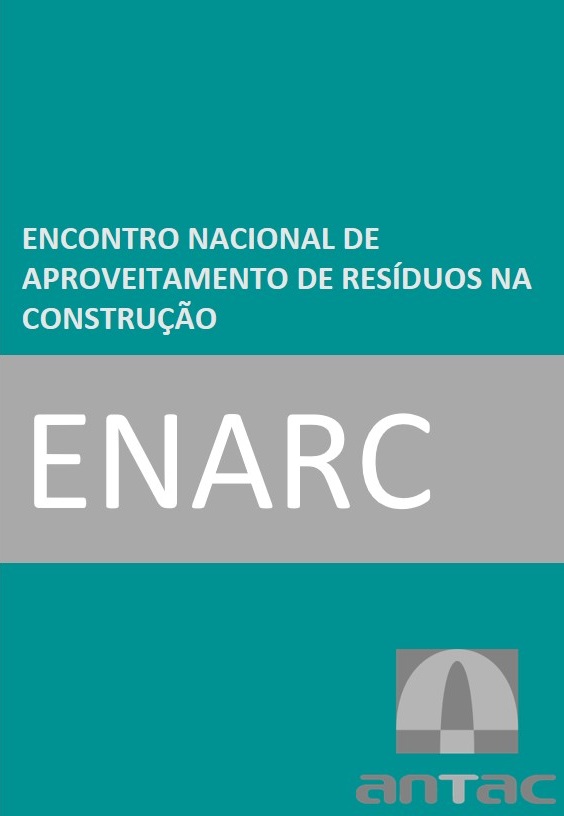Efficiency of grinding of powder (<0,15 mm) recycled from Civil Construction Waste (CCW) in the presence of additive
DOI:
https://doi.org/10.46421/enarc.v8i00.3018Keywords:
Construction and Demolition Waste (CDW), Grinding additives, Dispersing, Supplementary Cementitious Materials (SCMs)Abstract
This study evaluates the grinding efficiency of the particle size and the specific surface (BET) of Civil Construction Waste powders (RCCs). For this, concrete powder (PC) and mixed powder (PM) were used as references, obtained through comminution, respectively, of concrete specimens and mixed recycled sand (ceramic and cementitious materials). The RCC powders were submitted to the grinding process in a planetary ball mill at different times (30, 60, 120, 180, and 240 minutes), levels (0.05, 0.1, 0.5 and 1%), and types of additives (Propylene glycol, Sodium hexametaphosphate, and Triethanolamine). The results show that the most efficient treatment (grinding) for the concrete powder was 60 minutes in the presence of the Propylene glycol additive at a content of 1% para. For the mixed powder, should check other additive contents, in case there is a need for a finer material.
References
ASSOCIAÇÃO BRASILEIRA DE NORMAS TÉCNICAS - ABNT. NBR 16605: Cimento Portland e outros materiais em pó — Determinação da massa específica. Rio de JaneiroAssociação Brasileira de Normas Técnicas, , 2017.
ABRECON. Pesquisa setorial ABRECON 2020: a reciclagem de resíduos de construção e demolição no Brasil. [s.l: s.n.].
AKHTAR, A.; SARMAH, A. K. Construction and demolition waste generation and properties of recycled aggregate concrete: A global perspective. Journal of Cleaner Production, v. 186, p. 262–281, 2018.
BREKAILO, F. et al. Evaluation of the reactive potential of additions of red ceramic waste and comminuted concrete of CDW in cement matrix. Ceramica, v. 65, n. 375, p. 351–358, 2019.
COSTA, A. R. D.; GONÇALVES, J. P. Milling parameters and solid waste characterisation to use as supplementary cementitious materials. Ambiente Construído, v. 22, n. 4, p. 35–48, 2022.
DUAN, Z. et al. Combined use of recycled powder and recycled coarse aggregate derived from construction and demolition waste in self-compacting concrete. Construction and Building Materials, v. 254, p. 119323, set. 2020.
FLORES, Y. C. et al. Performance of Portland cement pastes containing nano-silica and different types of silica. Construction and Building Materials, v. 146, p. 524–530, 2017.
KATSIOTI, M. et al. Characterization of various cement grinding aids and their impact on grindability and cement performance. Construction and Building Materials, v. 23, n. 5, p. 1954–1959, 2009.
KIM, Y. Quality properties of self-consolidating concrete mixed with waste concrete powder. Construction and Building Materials, v. 135, p. 177–185, mar. 2017.
MENG, T. et al. Comparison of technical properties of cement pastes with different activated recycled powder from construction and demolition waste. Cement and Concrete Composites, v. 120, n. March, p. 104065, 2021.
OLIVEIRA, D. R. B. et al. Pó de resíduo misto de construção como material cimentício suplementar: estudo em pastas empacotadas. Xix Encontro Nacional De Tecnologia Do Ambiente Construído, v. 19, p. 1–14, 2023.
OLIVEIRA, I. R. ET AL. Dispersão e empacotamento de partículas. Fazendo Ar ed. São Paulo: Fazendo Arte, 2000.
OLIVEIRA, T. C. F.; DEZEN, B. G. S.; POSSAN, E. Use of concrete fine fraction waste as a replacement of Portland cement. Journal of Cleaner Production, v. 273, p. 123126, 2020.
PRZIWARA, P. et al. Impact of grinding aids and process parameters on dry stirred media milling. Powder Technology, v. 335, p. 114–123, 2018.
SALES, A. T. C.; ALFERES FILHO, R. DOS S. Efeito do pó de resíduo cerâmico como adição ativa para o concreto. Ambiente Construído, v. 14, n. 1, p. 113–125, 2014.
SANTOS, R. P.; TUBINO, R. Potential evaluation of the use of construction and demolition waste (CDW) in the recovery of degraded soils by mining in Brazil. Resources, Conservation & Recycling Advances, v. 12, p. 200060, dez. 2021.
SCRIVENER, K.; SNELLINGS, R.; LOTHENBACH, B. A Practical Guide to Microstructural Analysis of Cementitious Materials. [s.l: s.n.].
SHI, C. et al. Performance enhancement of recycled concrete aggregate - A review. Journal of Cleaner Production, v. 112, p. 466–472, 2016.
SINGH, A. et al. Evaluation and comparison of mineralogical, micromeritics and rheological properties of waste machining chips, coal fly ash particulates with metal and ceramic powders. Powder Technology, v. 408, p. 117696, ago. 2022.
TOKAREVA, A.; KAASSAMANI, S.; WALDMANN, D. Fine demolition wastes as Supplementary cementitious materials for CO2 reduced cement production. Construction and Building Materials, v. 392, n. June, p. 31–35, 2023.
ULSEN, C. et al. Composição química de agregados mistos de resíduos de construção e demolição do Estado de São Paulo (Chemical composition of mixed construction and demolition recycled aggregates from the State of São Paulo). Mineração, v. 63, n. 2, p. 339–346, 2010.
WANG, L. et al. Eco-friendly treatment of recycled concrete fines as supplementary cementitious materials. Construction and Building Materials, v. 322, n. November 2021, p. 126491, 2022.
ZHANG, D. et al. Comparison of mechanical, chemical, and thermal activation methods on the utilisation of recycled concrete powder from construction and demolition waste. Journal of Building Engineering, v. 61, p. 105295, dez. 2022.
ZHOU, L. et al. Influence of recycled concrete powder (RCP) and recycled brick powder (RBP) on the physical/mechanical properties and durability of raw soil. Coatings, v. 11, n. 12, 2021.

